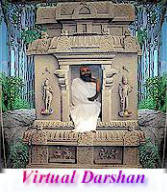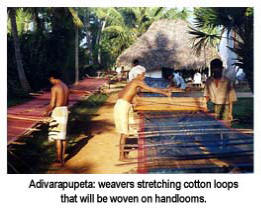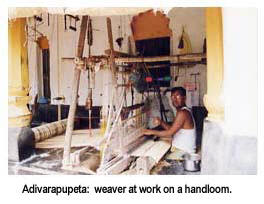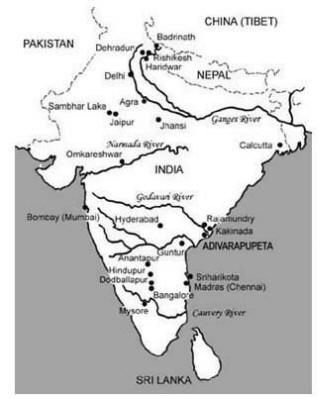|
|
Adivarapupeta On the east coast of India near the mouth of the sacred Godavari River is a small rural town named Draksharam. It is located in the East Godavari District of the state of Andhra Pradesh, about thirty kilometers from the seaport of Kakinada and about forty kilometers from the major railroad station of Rajamundry. Draksharam is famous for its ancient temple in which the presiding deity is Bheemeshwara Mahadeva, a naturally occurring linga (svayambhu linga) revered as one of the twelve lingas of light (jyoti lingas) of India. A linga is a stone in the tall, rounded shape of the soul, a form of the God Shiva. A little more than a kilometer away from Draksharam, nestled among groves of palmyra and coconut palms and surrounded by lush rice paddy fields is the quiet village of Adivarapupeta. A small canal with water from the Godavari flows along the outskirts of this hamlet.
Its inhabitants, about two thousand in the late 1940’s, belonged predominantly to the Devanga community, a sub-caste throughout India whose occupation is the weaving of cloth. Unlike weavers in towns and cities, the villagers in Adivarapupeta had no power looms. They used hand looms to weave colorful cotton sarees for women and the white dhoties that men wrap around their waists like a skirt.
In the early decades of the 20th century there lived in Adivarapupeta a man named Allaka Bheemanna. Dark in appearance and short in height, he belonged to the Devanga community. Like almost everyone in Adivarapupeta, Bheemanna used a hand loom to weave cotton dhoties and sarees for a living. Bheemanna’s first wife, Shravanamma, came from the village of Bandarulanka on the other side of the Godavari River, about twenty kilometers from Adivarapupeta. As the couple did not have any children Bheemanna, with the consent of Shravanamma, decided to marry again. His second wife was Parvati, a young woman who was born in the village of Hasanbad between Draksharam and Kakinada. She became known as Parvatamma. Adivarapupeta is a poor village, and most of its houses were made of mud bricks and thatched roofs. They typically had one room that the family shared in common, and a kitchen area separated by a partial wall. The floors were made of dirt, wetted, packed and swept to make a hard surface. Bheemanna was among the poorest of the weavers. He had a one-loom household, actually, half of a house. The other half belonged to his brother. They shared a common thatched roof, but the two brothers had constructed a dividing wall down the middle and each household had its own kitchen. In such households, mothers gave birth in the kitchen. It was the only space available to afford some privacy. When the woman was about to deliver, the cooking would be shifted out of that area, curtains or some screen would be arranged, and she would give birth. It was in this manner that Parvatamma gave birth to six children, four of whom survived. Her youngest child, a son named Sathyaraju, was born on the 24th of January, 1935, at 2:45 in the afternoon. This boy became Shri Shri Shri Shivabalayogi Maharaj.
|
 |
|
His Life |
| birth |
| childhood |
| childhood stories |
| enlightenment |
| beginning tapas |
| early obstacles |
| four directions |
| tapas completion |
| Adivarapupeta |
|
Ardhanarishwara Linga & Devi |
| India travels |
|
Banagalore ashram temple |
| Adivarapupeta ashram |
| in the West |
| mahasamadhi |
|
|
| yogi |
| religions |
| spiritual leaders |
| Jesus & Buddha |
| God |
| forms of God |
| guru-devotee |
| Swamiji's mission |
| initiation, vibhuti |
| meditation |
| samadhi (enlightenment) |
| tapas & Self realization |
| bhajans(devotional song) |
|
bhava samadhi (spiritual trance) |
| world conditions |
| foundation |
| Swamiji's words |
| Virtual Darshan |
|
|
|
Shri Shivabalayogi Maharaj
International Trust P.O. Box 293 Langley, WA 98260 U.S.A. info@Shiva.Org |
 In
the 1930’s, Adivarapupeta was a rustic village of mostly mud-walled,
thatched roof huts. A wide dirt road served as the main street and work
area for the villagers. There was an occasional concrete and tile roof
house and some community water wells, but no electricity, no telephone,
no sewer, no shops, not even a road that connected the village to the
outside world. The village was surrounded by rice paddy fields separated
by irrigation ditches and banks on which people, bicycles and livestock
traveled.
In
the 1930’s, Adivarapupeta was a rustic village of mostly mud-walled,
thatched roof huts. A wide dirt road served as the main street and work
area for the villagers. There was an occasional concrete and tile roof
house and some community water wells, but no electricity, no telephone,
no sewer, no shops, not even a road that connected the village to the
outside world. The village was surrounded by rice paddy fields separated
by irrigation ditches and banks on which people, bicycles and livestock
traveled. The
Birth of Sathyaraju
The
Birth of Sathyaraju Bheemanna
had some knowledge of astrology. He could read the traditional calendar
(panchangam) and some of the villagers used to come to him to
check for an auspicious date and time to schedule important events in
their lives. Shortly after Sathyaraju was born, his father drew the
child’s horoscope. It revealed that when the boy would be about two
years of age, either Bheemanna would die and the boy would become a
great man, or the boy would die. Bheemanna often used to tell Parvatamma
that he would not live to see their younger son make a great name for
himself and bring great honor to the family. The prediction came to
pass. In the month of July, 1937, when Sathyaraju was barely two and a
half years old, his father passed away.
Bheemanna
had some knowledge of astrology. He could read the traditional calendar
(panchangam) and some of the villagers used to come to him to
check for an auspicious date and time to schedule important events in
their lives. Shortly after Sathyaraju was born, his father drew the
child’s horoscope. It revealed that when the boy would be about two
years of age, either Bheemanna would die and the boy would become a
great man, or the boy would die. Bheemanna often used to tell Parvatamma
that he would not live to see their younger son make a great name for
himself and bring great honor to the family. The prediction came to
pass. In the month of July, 1937, when Sathyaraju was barely two and a
half years old, his father passed away.